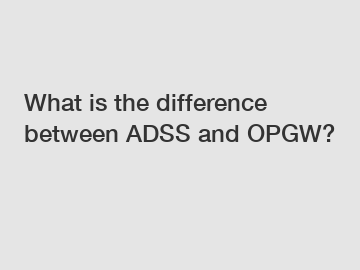What is the difference between ADSS and OPGW?
What is the difference between ADSS and OPGW?
ADSS (All-Dielectric Self-Supporting) and OPGW (Optical Ground Wire) are two types of fiber optic cables used in the communication and power transmission industries. While both cables serve a similar purpose of providing data and power transmission capabilities, they have distinct differences in terms of their construction, functionality, and performance.
The difference between ADSS and OPGW can be primarily attributed to their composition. ADSS cables are made entirely of dielectric materials, such as aramid fibers and polymer coatings. On the other hand, OPGW cables have a hybrid construction, consisting of a central steel or aluminum conductor surrounded by optical fibers and further protected by metal and dielectric layers. This distinction in composition contributes to the contrasting characteristics and performance of these cables.

In terms of functionality, ADSS cables are designed for aerial installations, where they can be self-supporting and suspended from utility poles or other structures without the need for additional hardware. This makes them more suitable for long-span applications, as they can bear their weight and the stress caused by environmental factors, such as wind and ice. In contrast, OPGW cables are primarily used as a grounding wire in overhead power transmission lines. They offer both electrical conductivity for grounding purposes and optical fiber capacity for data transmission.
The key difference in performance between ADSS and OPGW lies in their ability to withstand mechanical stresses. Due to the use of dielectric materials, ADSS cables have a greater resistance to electrical interference and can provide higher tensile strength. This makes them more suitable for installations in areas prone to electrical surges or where high mechanical tension is expected. OPGW cables, on the other hand, have a higher current-carrying capacity and are better equipped to handle power transmission requirements.
The choice between ADSS and OPGW depends on various factors, including the specific application, installation environment, and budget. ADSS cables are commonly used in telecommunication networks and areas with limited available support structures. They are favored for their ease of installation and lower cost compared to OPGW. OPGW cables are widely used in power utility networks to ensure efficient power transmission while simultaneously providing a means for data communication.
In conclusion, the difference between ADSS and OPGW lies in their composition, functionality, and performance characteristics. Understanding these differences enables professionals in the communication and power transmission industries to make informed decisions regarding the selection and deployment of the most appropriate fiber optic cable for their specific needs. Whether it is the self-supporting nature of ADSS or the dual functionality of OPGW, both cables play vital roles in ensuring reliable data transmission and efficient power distribution in modern infrastructure.
For more adss opgw, adss hardware, tension clamp for overhead linesinformation, please contact us. We will provide professional answers.



Comments
0